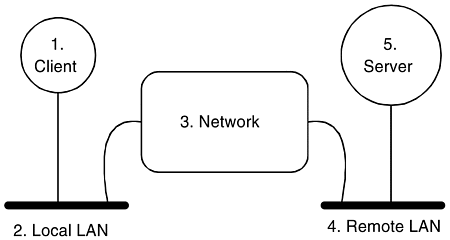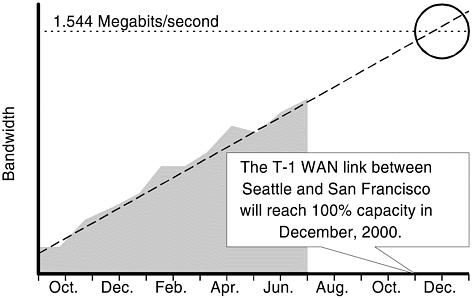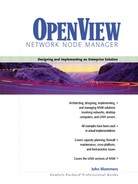Who Needs Performance Data?
Network performance data is an essential component of network management because:
“you can’t manage what you don’t measure.”
Performance information is needed at every stage in a network’s evolution. Those stages include requirements, architecture, design, implementation, routine maintenance, and upgrades. Therefore, it’s common to depend on SNMP agents in the network to provide performance data and to use an SNMP-based network management system like NNM to collect it. Consumers of network performance data include troubleshooters, the help desk, network engineering, SLA administrators, financial planners, and system administrators.
Troubleshooters need both real time and historic data to diagnose the root cause of user complaints. They will usually locate the path traffic takes between the user’s workstation and the server (see Figure 9-1) and check on media utilization and error percentage rates. If the problem symptoms are active, then a real-time view is necessary. If the problem symptoms have passed, then the historical data at the time the problem occurred is what’s needed.
Figure 9-1. Potential performance problem locations.
Troubleshooting network problems between a client system and the corresponding server requires that five locations be instrumented. A performance problem might be caused by a lack of resources, excessive utilization, CRC errors, or packet loss. SNMP agents located at locations 1-5 can help isolate the problem and correct the direction of fingerpointing.

The help desk staff needs to view capacity, error, and packet loss data as they collect basic information about a user complaint. If the user’s workstation has a working SNMP agent, it’s possible to measure performance data for its LAN adapter; for advanced agents, resource usage such as CPU, RAM, and disk is available. Server systems almost always support SNMP. Client, network, and server systems are all involved in most user performance complaints, so it’s important to measure SNMP data at all of them to isolate the true cause. Performance problems are not always caused by the network. For example, it is entirely possible that poor client-server response time is caused by the client having too many applications open, resulting in excessive virtual memory (VM) activity.
The network engineering staff needs operational metrics to validate network changes and bandwidth upgrades. Knowing link utilization is important, but so is knowing the source-destination metrics for various applications. For example, some web traffic will be directed to local servers and the rest may be destined for the Internet via the firewall. The same is true for e-mail. File and print traffic is usually sent to a local file server and a local LAN-attached printer. An understanding of application-specific source-destination pairs provides valuable insight into how a network redesign should be done. While simple link-based utilization data can be used to correct a bandwidth allocation problem, RMON2-based data is needed to collect application-specific source-destination pairs. Display tools such as HP NetMetrix can display this data graphically and create tabular reports as well. This performance data is often input to a more comprehensive network capacity planning process. This validates that a given network design, which clearly provides the necessary connectivity, also provides the necessary performance.
The IT organization needs metrics to comply with service level agreements (SLA) and their user communities. Each user community is a special interest group with specific network needs, and an SLA is an agreement between them and IT about what level of service is expected. The metrics agreed upon must be realizable and measurable. Application response time is very difficult to measure when developers have not instrumented the code. Code that is instrumented using the application resource monitor (ARM) APIs is very easy to monitor with the standard HP PerfView application. Without ARM-enabled application code, simpler SNMP measurable metrics such as utilization are typically the basis for the SLA.
Financial planners use historical performance data to demonstrate to management why money is needed to upgrade the network. A properly presented line chart depicting historical traffic growth plus a credible forecasting technique can ethically and accurately depict the urgency for a network upgrade. See Figure 9-2.
Figure 9-2. Projecting capacity using SNMP data.
NNM can collect historical SNMP utilization data from a router interface. Repurposing the data into a professional presentation gives impact to the message that a network upgrade is critical.

Even system administrators benefit from knowing traffic patterns when they decide where a new server is best placed, much like network designers who benefit from knowing the source-destination traffic a new server will generate.
